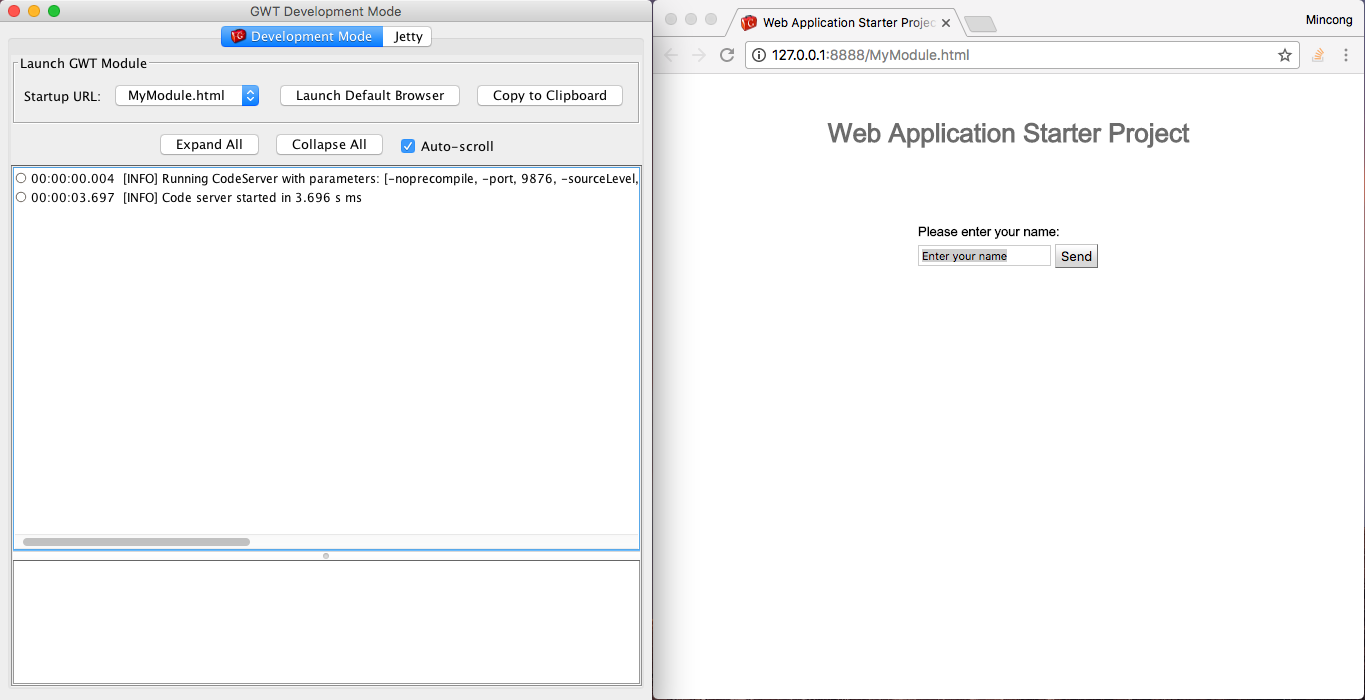Today, I want to share how to learn GWT 2.8 with Maven GWT Plugin. I wrote this post because the official GWT tutorial has some inconvenience: source code and resources are stored as GWT standard structure, commands must be launched from Apache Ant, JARs and classpath must be handled explicitly etc. I found it more comfortable to start with Maven, the tool which many Java developers are familiar with. Before getting started, please be sure that the following tools are installed in your computer:
- JDK 8
- Maven 3
Create a Project
Build a sample GWT application with Maven is easy. You can use the archetype
provided by GWT Maven plugin. An archetype is defined as an original pattern or
model from which all other things of the same kind are made. Suppose that you
want to create a GWT application for group com.mycompany, artifact
my-app, version 1.0-SNAPSHOT, and GWT module called MyModule. Then you can
create your project in the following batch mode:
$ mvn -B archetype:generate \
-DarchetypeGroupId=org.codehaus.mojo \
-DarchetypeArtifactId=gwt-maven-plugin \
-DarchetypeVersion=2.8.1 \
-DgroupId=com.mycompany \
-DartifactId=my-app \
-Dversion=1.0-SNAPSHOT \
-Dmodule=MyModuleOtherwise, you can create your project in interactive mode. And fill all the required parameters in your terminal:
$ mvn archetype:generate \
-DarchetypeGroupId=org.codehaus.mojo \
-DarchetypeArtifactId=gwt-maven-plugin \
-DarchetypeVersion=2.8.1No matter which mode you used, the result should be successful:
...
[INFO] ----------------------------------------------------------------------------
[INFO] Using following parameters for creating project from Archetype: gwt-maven-plugin:2.8.1
[INFO] ----------------------------------------------------------------------------
[INFO] Parameter: groupId, Value: com.mycompany
[INFO] Parameter: artifactId, Value: my-app
[INFO] Parameter: version, Value: 1.0-SNAPSHOT
[INFO] Parameter: package, Value: com.mycompany
[INFO] Parameter: packageInPathFormat, Value: com/mycompany
[INFO] Parameter: package, Value: com.mycompany
[INFO] Parameter: version, Value: 1.0-SNAPSHOT
[INFO] Parameter: groupId, Value: com.mycompany
[INFO] Parameter: module, Value: MyModule
[INFO] Parameter: artifactId, Value: my-app
[INFO] Project created from Archetype in dir: /Users/mincong/Desktop/my-app
[INFO] ------------------------------------------------------------------------
[INFO] BUILD SUCCESS
[INFO] ------------------------------------------------------------------------
[INFO] Total time: 7.858 s
[INFO] Finished at: 2018-01-29T21:51:53+01:00
[INFO] Final Memory: 22M/1039M
[INFO] ------------------------------------------------------------------------
Understand GWT Project Structure
In the next step, we’ll explore the project structure created by Maven GWT plugin.
$ tree my-app/
my-app/
├── pom.xml
├── src
│ ├── main
│ │ ├── java
│ │ │ └── com
│ │ │ └── mycompany
│ │ │ ├── client
│ │ │ │ ├── GreetingService.java
│ │ │ │ ├── Messages.java
│ │ │ │ └── MyModule.java
│ │ │ ├── server
│ │ │ │ └── GreetingServiceImpl.java
│ │ │ └── shared
│ │ │ └── FieldVerifier.java
│ │ ├── resources
│ │ │ └── com
│ │ │ └── mycompany
│ │ │ ├── MyModule.gwt.xml
│ │ │ └── client
│ │ │ └── Messages_fr.properties
│ │ └── webapp
│ │ ├── MyModule.css
│ │ ├── MyModule.html
│ │ └── WEB-INF
│ │ └── web.xml
│ └── test
│ ├── java
│ │ └── com
│ │ └── mycompany
│ │ └── client
│ │ └── GwtTestMyModule.java
│ └── resources
│ └── com
│ └── mycompany
│ └── MyModuleJUnit.gwt.xml
└── target
└── generated-sources
└── gwt
└── com
└── mycompany
27 directories, 13 filesAs you can see, 27 directories and 13 files have been created.
Application Source Folder
src/main/java, the application source folder, it contains only Java files.
Such files are separated in 3 categories: client, server, and shared. Client
files will be transpiled from Java to JavaScript, and be executed in user’s
browser. Server files will be compiled into bytecode, and be executed on the
server as normal Java files. Shared files are different. They will be shared
between client side and server side, via RPC—Remove Procedure Call.
Application Resources Folder
src/main/resources, the application resources folder, it contains the GWT
module definition, written in XML file. Module XML files is resided in project’s
root package. Its related path to resources folder is:
./com/mycompany/MyModule.gwt.xml
Such naming convention helps GWT to define the logical name of the module:
com.mycompany.MyModule
Web Application Sources Folder
src/main/webapp, the web application sources, it contains static resources
used by the web application, and the deployment descriptor file web.xml.
Notice that when using the DevMode, the resources in this folder are not
refreshable.
Test Sources Folder
src/test/java, the test sources, it contains GWT tests. GWT tests are
different from classical unit tests. They are transpiled from Java to JavaScript
before being executed. GWT includes a special GWTTestCase base class that
provides JUnit integration. Running a compiled GWTTestCase subclass under
JUnit launches the HtmlUnit browser which serves to emulate your application
behavior during test execution. Since these tests are launched in browser, they
are actually integration tests. Naming test as GwtTest means:
- They won’t be executed at
testphrase (avoid matching*TestandTest*). - They will be executed at
verifyphrase by Maven GWT Plugin. - They won’t be executed as normal integration tests by Maven Failsafe Plugin.
Test Resources Folder
src/test/resources, the test resources, is very similar to application
resources.
Run DevMode
The standard src/main/webapp webapp folder is used by Maven GWT Plugin to run
the dev mode server (Jetty).
mvn gwt:run
And you can now see the GWT Development Mode. When clicking the button “Launch Default Browser”, you can see the result in your browser:

Testing
The Maven GWT Plugin testing support is not intended to be run standalone,
rather it is bound to the Maven integration-test phase. To get gwt:test to
run, you should include the test goal in your plugin configuration executions,
and you should invoke mvn verify (or mvn install).
mvn verify
Conclusion
Today we learnt how to use GWT Maven Plugin to create a quick start project by following the standard Maven layouts. Some basic thinking about the different folders. We also use the 2 basics Maven commands for running application in development mode, and running GWT tests. Hope you enjoy this post, see you the next time.